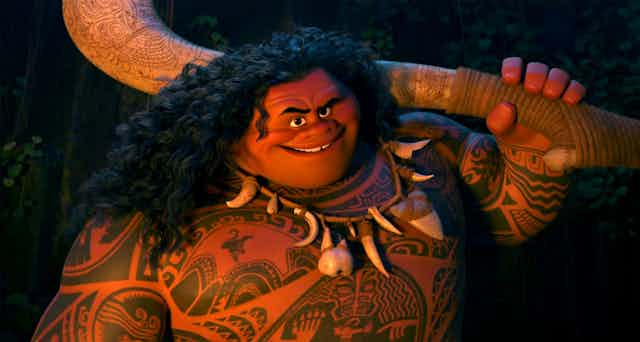People don blackface with disturbing regularity in Australia. The fact that they do highlights an ongoing lack of understanding of what blackface symbolises and why people find it offensive.
For example, in September 2018 three Tasmanian footballers apologised after they dressed in blackface for an end-of-year celebration. Two went as tennis players Serena and Venus Williams, and another as AFL player Aliir Aliir.
In 2016, Polynesian activists accused Disney of promoting “brownface” after it advertised a full body children’s costume depicting the tattooed Pacific demi-god Maui. Weeks earlier, a Perth mother who painted her son’s skin black so he could dress for a school parade as his “idol”, AFL footballer Nic Naitanui, was widely criticised for promoting “blackface”.
Earlier in 2016 Australian Opals basketball team member Alice Kunek apologised after posting a photo of herself on Instagram in blackface.
To help explain why blackface is more than a simple case of harmless parody or even “honouring your hero,” it is important to understand its historical beginnings.
Early history
In medieval Europe, blackface was often used for entertainment. For example, in France and Italy, black masked figures would act out antisocial behaviour such as crudeness, violence or magic.
In 19th century America, white performers would put dark paint on their faces and perform ridiculous stereotypes about African Americans in Minstrel shows. As Norm Sheehan has written, blackface began as a popular movement that ridiculed and lampooned African Americans leading up to the American Civil War. It continued until the 1970s.
In Melbourne, in the 1880s, writes historian Melissa Bellanta, the Apollo Hall was a blackface minstrel venue. Audiences cheered on white actors with their faces painted with burnt cork and more unusually, a group of African American performers known as the Georgia Minstrels also performed blackface caricatures.
Bellanta highlights that “blackness” was historically used to symbolise social groups, beliefs and behaviours that were despised by society at the time.
More than just skin-deep
Blackface has frequently been used to perpetuate demeaning stereotypes of people of colour and symbolises how people who are not white have been represented as “the other”. It is widely seen as a form racism.
At its heart, “blackface” is about power. Specifically, using one’s power to take something important from someone else and use it for ridicule or entertainment. More recently, blackface has been used to target Aboriginal and Torres Strait Islander Australians. In one notorious incident, The Footy Show’s Sam Newman blackened his face to portray AFL star Nicky Winmar. At the time, Winmar was in the spotlight for speaking out against racism in Aussie rules, famously pointing to his skin on the field and declaring: “‘I’m black - and I’m proud to be black!”
Newman’s blackface ridicule of Winmar undermined his important status as an anti-racism activist. Even if this was unintentional, it showed the potentially serious implications of what some regard as “just harmless fun”.
A more challenging case of blackface occurred in early 2016, when a Hungarian journalist Boglarka Balogh photoshopped her own face onto portraits of black women.
Boglarka Balogh posted the project I Morphed Myself Into Tribal Women To Raise Awareness Of Their Secluded Cultures in late December 2015, writing that the portraits set out to celebrate “stunning tribal beauties at the brink of extinction”. But her actions were widely condemned.
So what about people who say they are using blackface as a form of homage? Here again, we should return to the question of power and control.
Regardless of intent, you can’t separate blackface from its colonial history – because the negative effects of this history still shape people’s lives today. And should people have the right to take someone else’s ethnicity for a day, use it for their own purposes and then drop it?
The dominant (white) culture has, for so long, taken things from people of colour – whether it be stories or treasures – because it could. In the case of the Maui outfit, for instance, culturally significant tattoos have a very specific meaning. Indeed the co-leader of New Zealand’s Maori Party Marama Fox, accused Disney of aiming to “make a profit off the back of another culture’s beliefs and history”.
The history of blackface has shown us that, regardless of intent, this practice cannot be seen as respectful and will offend people.
As indigenous affairs reporter Allan Clarke responded when challenged by Steve Price on The Project for getting upset about Kunek’s blackface photos:
Let the people of colour define what’s racist. Let them define what’s offensive to them.
I use the history of blackface as an important example when teaching allied health professional students about cultural safety. If we want to have a more harmonious society then we should stop doing these things as they are offensive and distressing to some citizens.

